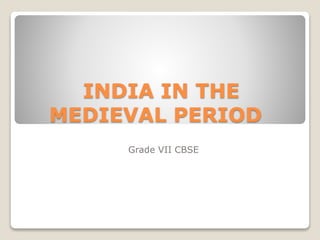India in the medieval period
•Transferir como PPTX, PDF•
10 gostaram•9,431 visualizações
Grade VII
Denunciar
Compartilhar
Denunciar
Compartilhar

Recomendados
Recomendados
Mais conteúdo relacionado
Mais procurados
Mais procurados (20)
Towns, Traders and Craftspersons, History class 7 cbse

Towns, Traders and Craftspersons, History class 7 cbse
Semelhante a India in the medieval period
Semelhante a India in the medieval period (20)
H - Story of the Indian I & II.pdf STATE AND UNION TERRITORY

H - Story of the Indian I & II.pdf STATE AND UNION TERRITORY
Colonialism and underdevelopment of indian economy

Colonialism and underdevelopment of indian economy
Colonialism and underdevelopment of indian economy

Colonialism and underdevelopment of indian economy
G 7 his ch-2 ppt new kings and kingdoms full chapter 

G 7 his ch-2 ppt new kings and kingdoms full chapter
Mais de Girish Arabbi
Mais de Girish Arabbi (20)
Último
Último (20)
Unit-IV; Professional Sales Representative (PSR).pptx

Unit-IV; Professional Sales Representative (PSR).pptx
This PowerPoint helps students to consider the concept of infinity.

This PowerPoint helps students to consider the concept of infinity.
On National Teacher Day, meet the 2024-25 Kenan Fellows

On National Teacher Day, meet the 2024-25 Kenan Fellows
General Principles of Intellectual Property: Concepts of Intellectual Proper...

General Principles of Intellectual Property: Concepts of Intellectual Proper...
Food safety_Challenges food safety laboratories_.pdf

Food safety_Challenges food safety laboratories_.pdf
India in the medieval period
- 1. INDIA IN THE MEDIEVAL PERIOD Grade VII CBSE
- 2. MAP OF INDIA DURING MEDIEVAL PERIOD Map of India Concept Map of Indian History Video
- 3. INTRODUCTION TO THE MEDIEVAL PERIOD • Medieval period in Europe extends from 5th to 15th century. • The Fall of Roman Empire marked the beginning of Europe’s medieval period. • This period also witnessed the beginning of Renaissance from the 14th to 16th centuries. • Medieval period laid stress on creativity and imagination, that resulted in artistic, scientific and cultural achievements. • Revival of trade led to the growth of cities and towns. • Modern education system and universities have their origins in medieval Europe.
- 4. Medieval Period in India • 8th cent to 18th cent. • The fall of the Gupta Empire marked the beginning of Medieval period in India. • This period is considered as an important milestone in the evolution of the composite culture of India. •
- 5. Major Historical Developments in Medieval India • Agriculture emerged as a primary occupation. • Several Rajput kingdoms emerged in northern and western parts of India. • Turks arrived in India and established Delhi Sultanate. • Establishment of Mughal Dynasty. • Cultural exchanges between Hindus and Muslims. • Reign of Muslim rulers ushered political stability. • Trade and commerce flourished and led to the development of towns and cities. Overseas trade developed die to better relations with foreign countries.
- 6. Major Historical Developments in Medieval India • Islam spread throughout India along with Sufi and Bhakti Movements. • Large scale development of art and architecture in India. • Hinduism and Islam developed as major religions. • European trading companies arrived in India.
- 7. Emergence of New Social and Political Groups and Kingdoms • The term ‘Kshatriya’ was introduced between 4th and 14th centuries.
- 8. New Dynasties emerging within the Indian borders.
- 14. REGION TO EMPIRE
- 15. Region to Empire • In 7th century big landlords or warrior chiefs ruled different regions of these kingdoms. • These landlords were also known as Samantas • Samantas provided military support to Kings. • These landlords, after getting power and wealth declared themselves as mahasamantas or mahamandaleshwars (the great lord of a cirlceor region)
- 16. Kingdom to Empire • Many new kings attained titles such as Maharaja-Adhiraja and tribhuvana-Chakravartin. • These kings shared their power with the samantas, associations of peasants, traders and Brahmins. • These kings gained importance, power and wealth. • Farmers, cattle keepers and artisans contributed to state revenue. • They were expected to pay tax. • Traders were also told to pay a part of their profit as tax.
- 17. Kingdom to Empire • As these kings became stronger regionally, they declared themselves as independent of any association with other kingdoms and samantas. • For example: Dantidurga defeated Chalukyas and established Rashtrakuta Empire
- 18. ECONOMIC CHANGES
- 30. SOURCES OF THE MEDIEVAL PERIOD SOURCESOFMEDIEVALHISTORY ARCHAEOLOGICAL SOURCES LITERARY SOURCES
- 32. Abdur Razzaq (Italy) visited the kingdom of Vijaynagar and wrote travelogues
- 33. Marco Polo (Venice) visited India during pre Mughal period
- 35. Uses of sourced for writing history • The sources throw ample light on social, economic and religious conditions of any particular period. • They give information on trade, mode of transport, extent of the empire and scientific development of that period. • The policies of the rulers and their achievements are highlighted through these sources. • The architectural skills of the workers, materials used for construction, customs and lifestyle of the people are revealed through these sources. • They are the most authentic sources of information in reconstructing the medieval history
